How to write a business proposal: template and tips from a business owner
6-minute read

Are you thinking about creating a business proposal template that you can use to sell more of your product or service?
And what is a business proposal, anyway? Putting a great one together can help you grow your business. Read on to find out what to include, plus advice from an experienced business owner, and download our free business proposal template.
What is a business proposal?
A business proposal is a document you send to a potential client to convince them to give you a particular job or contract.
It’s different from a business plan, which outlines your whole business idea before you start.
In some cases, a client will put out a request for proposal (RFP), asking you to state your case as to why you’re the best firm for the job. This is called a solicited business proposal.
In other cases, you might instigate the work by sending an unsolicited business proposal to a potential client. Or it may be something in between these two, where the idea comes up in a conversation and the client asks you to submit a proposal.
Why do you need a business proposal?
You may wonder why you need a business proposal, especially if you’ve put a lot of effort into marketing your business. But as well as acting as a business pitch, a business proposal can also protect you from potential disagreements down the line, as you’ll have expectations in place.
Richard Burle, owner of Richard's Garden Services in West Sussex, believes that laying out both your and your client’s expectations early on can be helpful. He explains that rubbish removal isn’t a service he offers, so he’s always conscious to be upfront about that when pitching to new clients.
Richard says: “I've had to create business proposals for working on larger gardens before. They've wanted to know what I’m going to do, what services I offer, and how many hours it’ll be.
“I’ll include that I’m going to cut the grass, I'm going to trim back the small shrubs – but I’ll also include that I don't take away rubbish. It's just not cost effective for me to do so.”
This honesty can be important to your customer service practices and relationship building with potential clients.
Download your business proposal template
We’ve created a business proposal template to help you create a professional-looking document and win new clients. Download it today and fill yours in by following the step-by-step guide below.
DownloadHow to write a business proposal
To help with sending future proposals, you might want to create a business proposal template. You can then edit it each time to make it specific to the business you’re pitching to.
For a business proposal to help you get the work you’re bidding for, it’ll usually need to include the following points. However, the client may have set out clear guidelines as to what proposal format they'll accept.
If the layout hasn't been set in stone, use these eleven points to create your basic business proposal template.
1. Title page
Include a title page to introduce your business and keep your document neat and tidy, giving a good first impression of the way you do business.
This should be well-designed, so include some imagery and text that addresses the client.
Visually speaking, this could be a great opportunity to show some examples of your work. Perhaps the front page image could be a house you renovated or a garden you designed? It’s important to use every page in your business proposal to your advantage.
2. Cover letter
Treat this as an introduction – instead of going in cold, include a letter outlining your business and your proposal, keeping it friendly and positive in tone.
Here’s an example of a contractor who is using a business proposal to pitch themselves for a job renovating and decorating a client’s home, using our downloadable business proposal template.
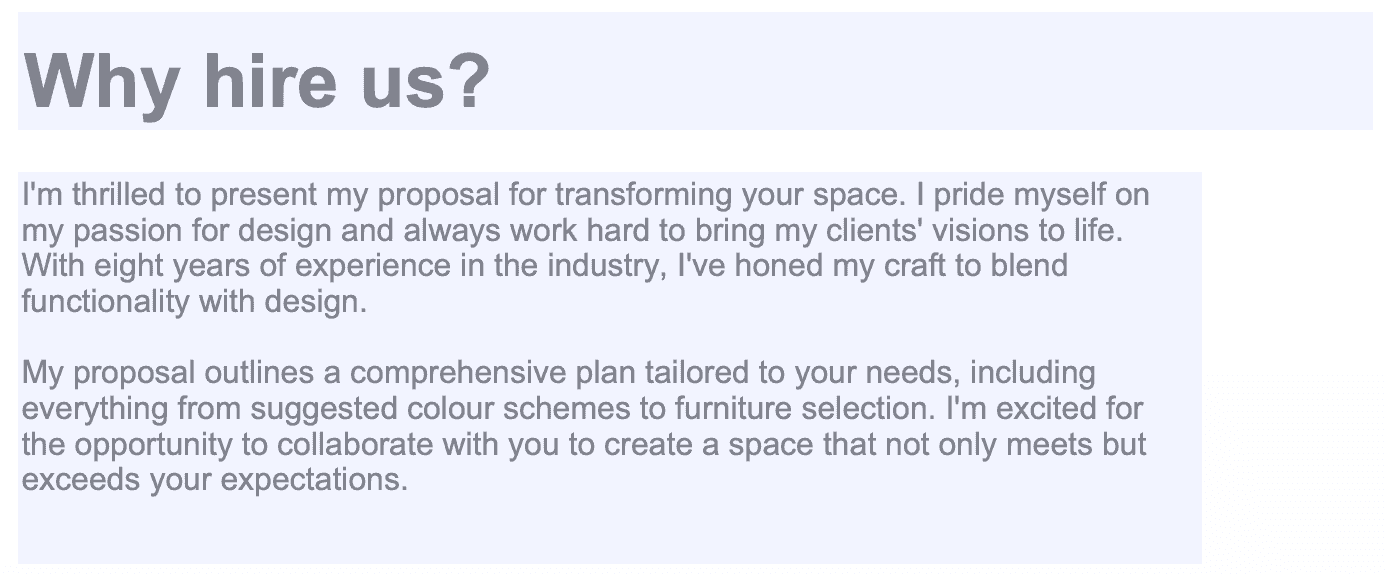
3. Table of contents
Let your potential client see at a glance what's included in your document and, if possible, make this section clickable so they can easily jump to any sections they want to re-read.
4. Executive summary
As a small business owner, you understand better than most how precious busy working people’s time can be. Keep this short, making it a high-level overview of the problem, the expected outcome, an overview of the solution, and a call to action.
Make sure that you avoid jargon throughout your executive summary (and business proposal as a whole), instead being clear and concise. If you use a term that you know you’d have to explain to your friends who aren’t in the industry, try to reword it for clarity.
5. Proposal
This is the part where you identify the gap that you’re going to fill. What’s your client’s problem and how are you going to solve it? It’s a good place to summarise your goals.
Don’t elaborate too much on your business, keeping it specific to your business proposal itself – and how it benefits your client.
Here’s how our our renovation contractor example would tackle writing the proposal:
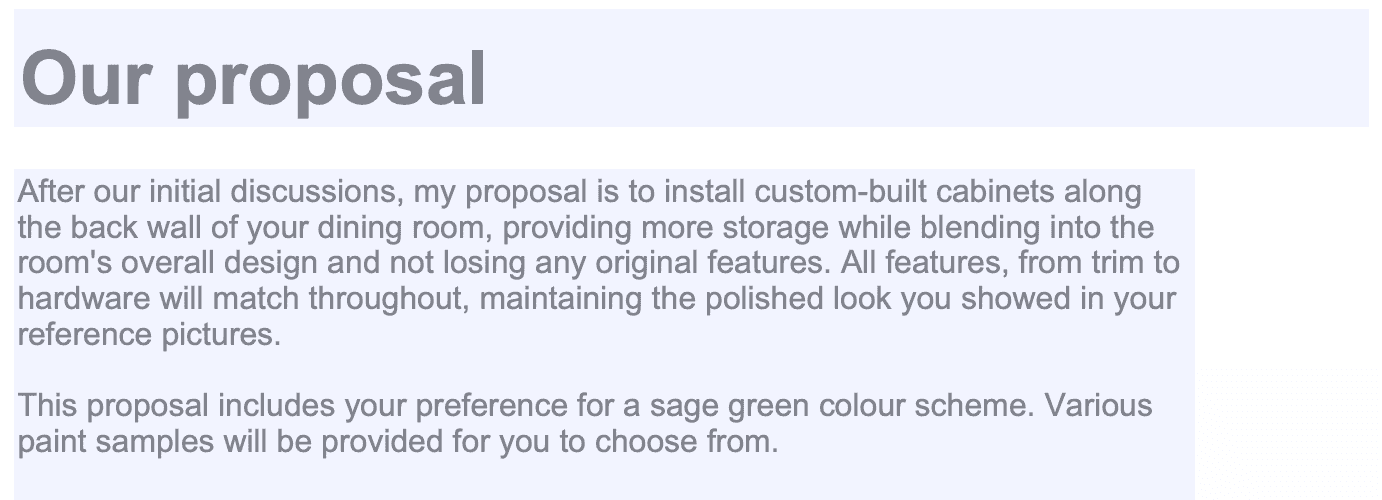
6. Services and methodology
How are you going to address the specific needs of the client? This is where you go into the finer details of what products or services the client will get out of your proposal and when they'll get them.
Be clear and detailed about what you’re offering, as well as how you’re going to get the work done. Both parties should be able to refer back to the document during the work to make sure that what was agreed is being done.
Then draw up a timeline to bring your proposal to life for the client and focus on developing a realistic delivery plan. More time is always better for you. But if your client has a specific date in mind (perhaps they’re launching a new product and your proposal is going to support it), then be sure to work to that.
Our renovation contractor example may show their methodology this way:
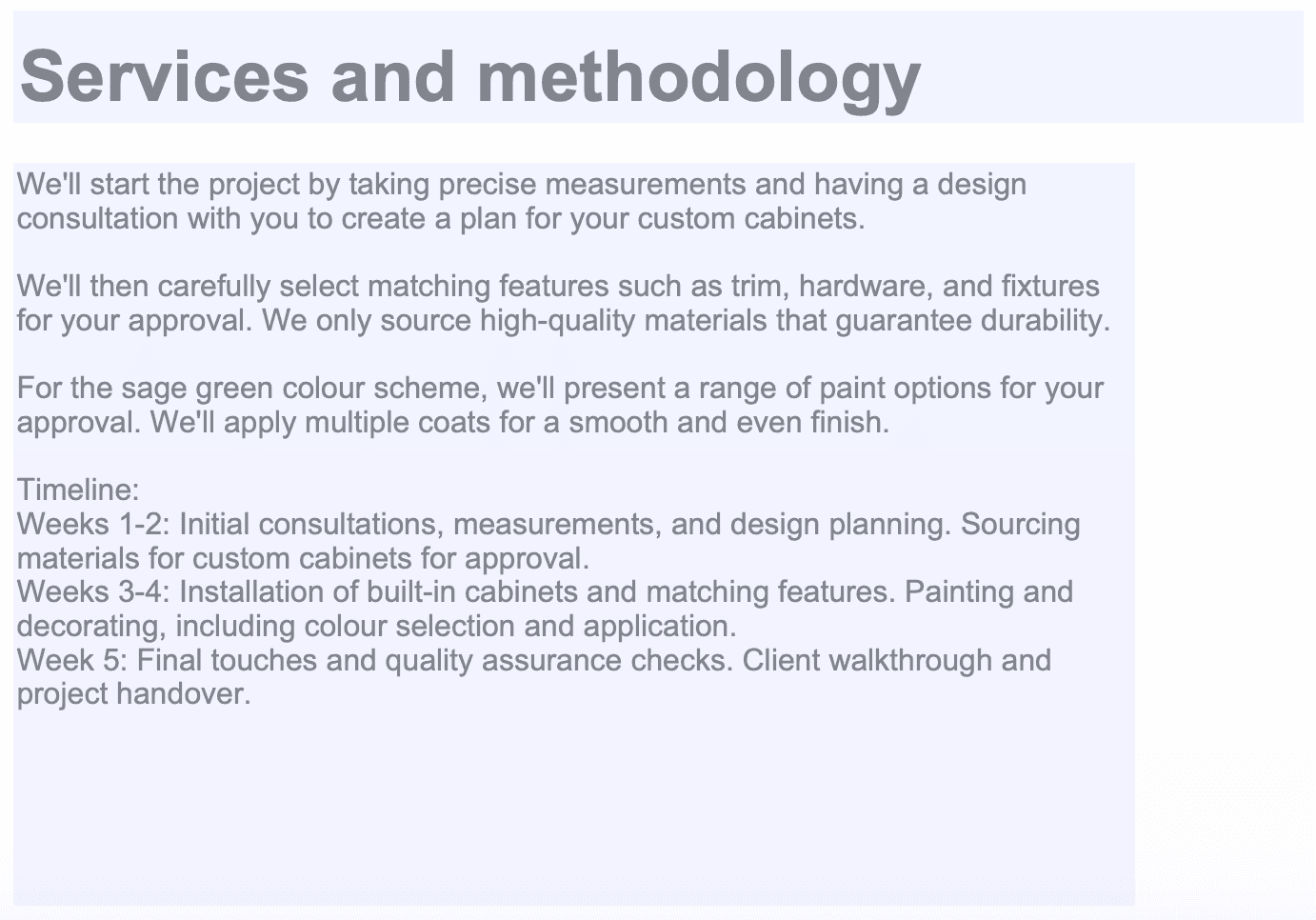
It’s important to also show the customer how you’ll be held accountable – let them know how much involvement they’ll have in the project.
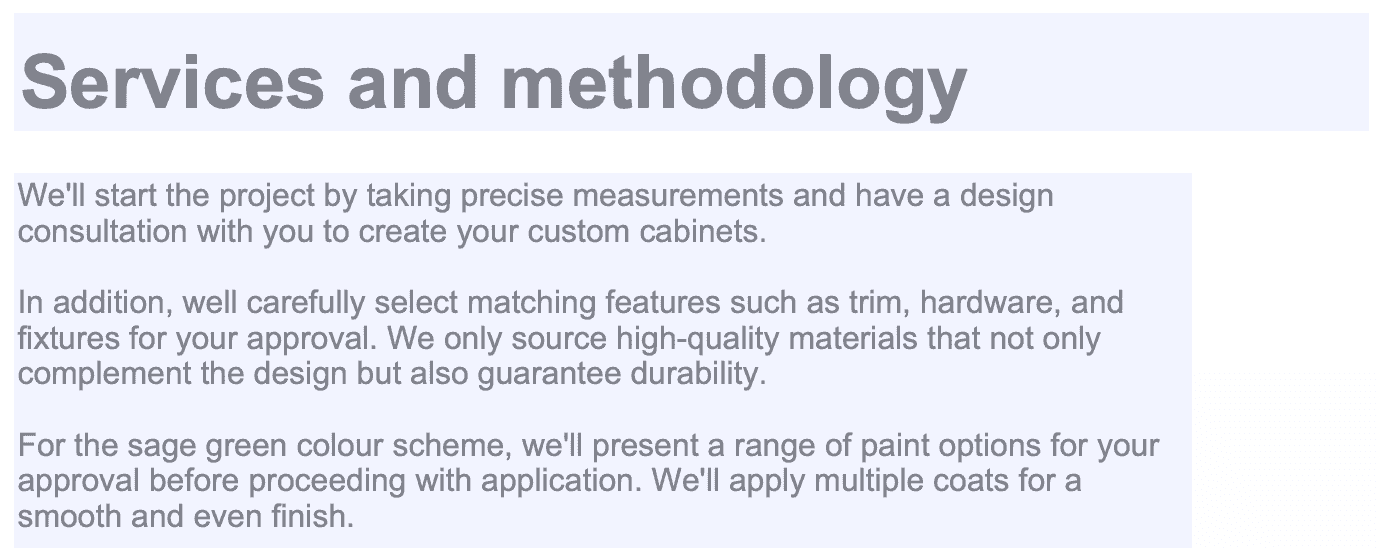
7. Why hire us?
This is your opportunity to sell your business as the best one for the job. What sets you apart from the competition? Let the client know about your experience of working on similar jobs, by using case studies. They’ll also be reassured to read bios of the person or people they'll be working with, as well as positive testimonials from customers you’ve worked with in the past.
Gardener Richard understands the importance of case studies and customer reviews in securing new business, revealing: “I've got a book with recommendations from my customers. So if I need to convince anyone, I’ll show them my book of what my customers think and I leave it up to them. They don’t have to take my word for it.”
You can also use social media to your advantage here, linking to your accounts if you frequently show your work online. This is something Richard does too:
“If you go on my Facebook page, you’ll see before and after pictures of gardens I've worked on. And once they've seen that, it normally convinces them.”
8. Costs
This self-explanatory section should let the client know how much it'll cost to put your proposal into action and what you expect the return to be. It's important to find the balance between overestimating, which can scare the client off, and underestimating, which can lead to disappointment in the future.
Richard believes that underselling yourself with a cheaper quote isn’t always the better choice, and that your price should reflect the quality of your work, saying: “You have to make your prices what you feel that you're worth and they should represent what you can actually do.
“I think a lot of gardeners, even established gardeners, are worried about putting their prices up. But when all your expenses are going up, you're working for less money.”
Richard believes that customers appreciate good quality work and will often pay more to make sure they get it. On losing out to bigger, cheaper businesses, he says:
“I’ve found most of the time when customers go for a cheap quote, they'd be there for a year, but after that the residents get fed up with the quality of work and choose somebody else.”
Read more: 5 ways to tell your customers about a price increase
9. Terms and conditions
Use this section to lay out what the client can expect from you and your business by agreeing to your proposal. This is a good place to set expectations as to payment and delivery dates.
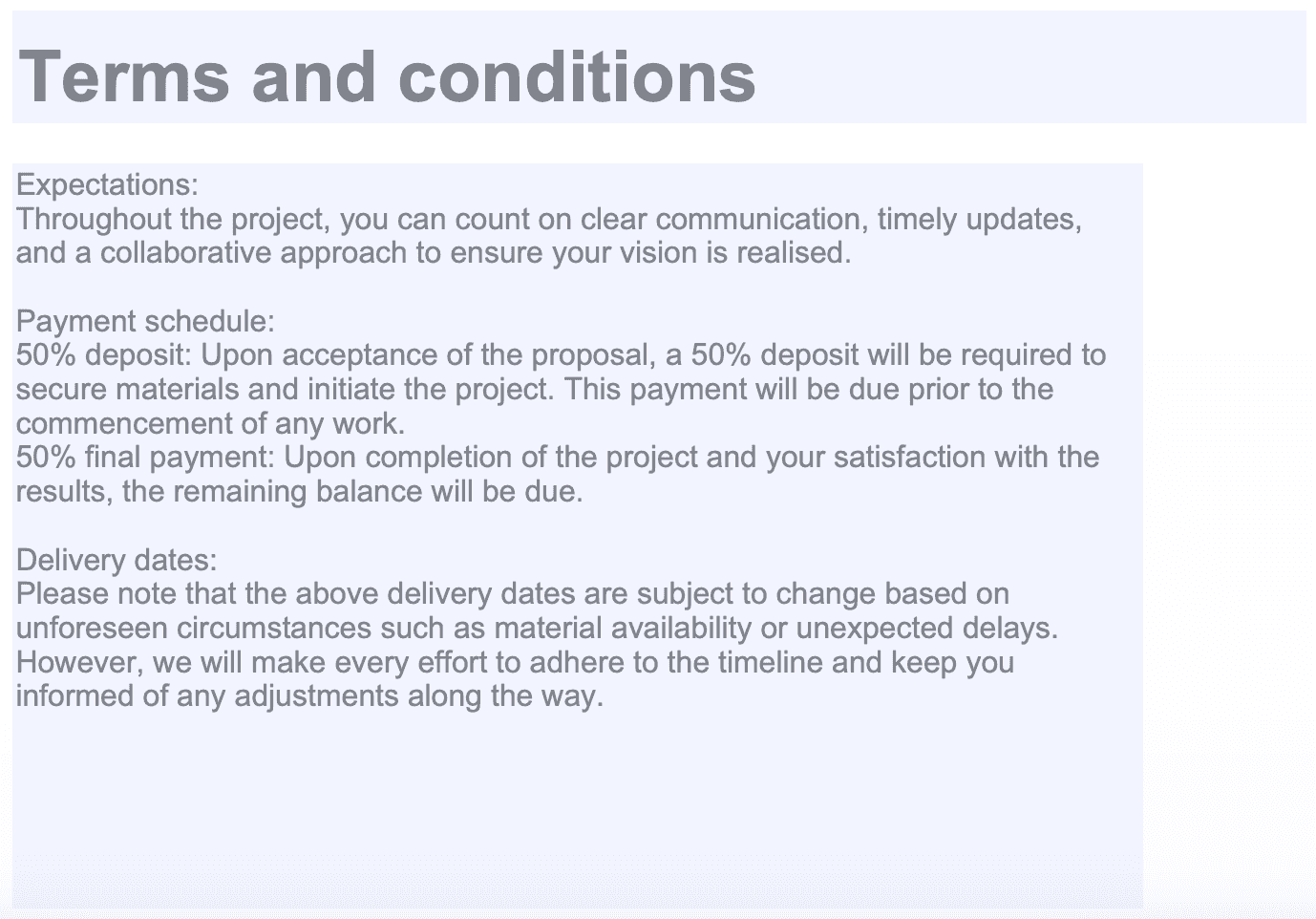
10. Agreement and call to action
Include a section where the client can formally agree to your proposal, with a gentle call to action to encourage them to sign.
You can make it as easy as possible for them to agree to your business proposal. For example, why not add a ‘Sign up today’ call to action, with a box that your client can add their signature to?
If you want to go for a less hard sell, let them know how to arrange a phone call to discuss your proposal further. Again, you can include a box that lets your client enter their availability.
11. Appendices (optional)
Do you have any reports or other forms of evidence to back up what you’ve said in the rest of your proposal? This is the place to include them.
How can you make your business pitch successful?
There are a few basic questions to ask when writing a business proposal. They may seem obvious, but it’s always worth double-checking.
Does your proposal make sense? Read it once, read it twice – and get a second pair of eyes to read it again.
Does your proposal provide value to the customer? The proposal that gives the client the greatest value will win the work, so make sure it’s yours.
Have you really understood what the customer needs? You may have a great idea, but it may not be aligned with what the customer wants – be sure to consider this.
Have you fully explained how you’ll fulfil those needs? If a client is going to give you work, they’ll need reassurance that you know what you’re doing – a detailed plan can help set their mind at ease.
Is your proposal visually appealing? If you send your proposal electronically, you can include visual content such as videos and images to bring your proposal to life for the client, and really set your document apart from the rest.
Useful guides for small businesses
Photograph 1: Seventyfour/adobe.stock.com
Ready to set up your cover?
As one of the UK's biggest business insurance providers, we specialise in public liability insurance and protect more trades than anybody else. Why not take a look now and build a quick, tailored quote?
Start your quote
Written by
Rosanna Parrish
Rosanna Parrish is a Copywriter at Simply Business, specialising in legal and HR content. Trained at London College of Communication, she has been creating content professionally for eight years at publications across the UK and Spain. Starting her career in health insurance, she also worked in education marketing before returning to the insurance world. Rosanna also writes about wellbeing in the workplace. She lives by the sea and does her best writing in coffee shops.
We create this content for general information purposes and it should not be taken as advice. Always take professional advice. Read our full disclaimer
Keep up to date with Simply Business. Subscribe to our monthly newsletter and follow us on social media.
Subscribe to our newsletterInsurance
Public liability insuranceBusiness insuranceProfessional indemnity insuranceEmployers’ liability insuranceLandlord insuranceTradesman insuranceSelf-employed insuranceRestaurant insuranceVan insuranceInsurersAbout
About usOur teamAwardsPress releasesPartners & affiliatesOur charitable workModern Slavery ActSection 172 statementSocial mediaSite mapAddress
6th Floor99 Gresham StreetLondonEC2V 7NG
Northampton 900900 Pavilion DriveNorthamptonNN4 7RG
© Copyright 2024 Simply Business. All Rights Reserved. Simply Business is a trading name of Xbridge Limited which is authorised and regulated by the Financial Conduct Authority (Financial Services Registration No: 313348). Xbridge Limited (No: 3967717) has its registered office at 6th Floor, 99 Gresham Street, London, EC2V 7NG.